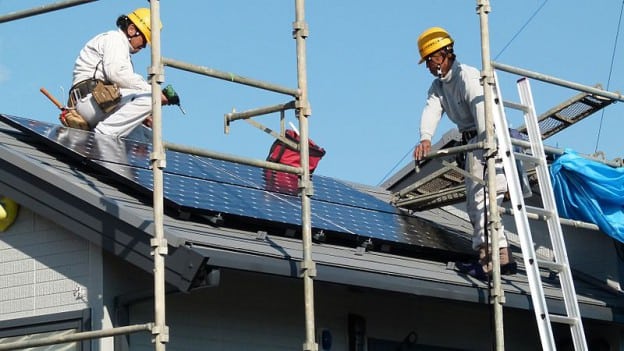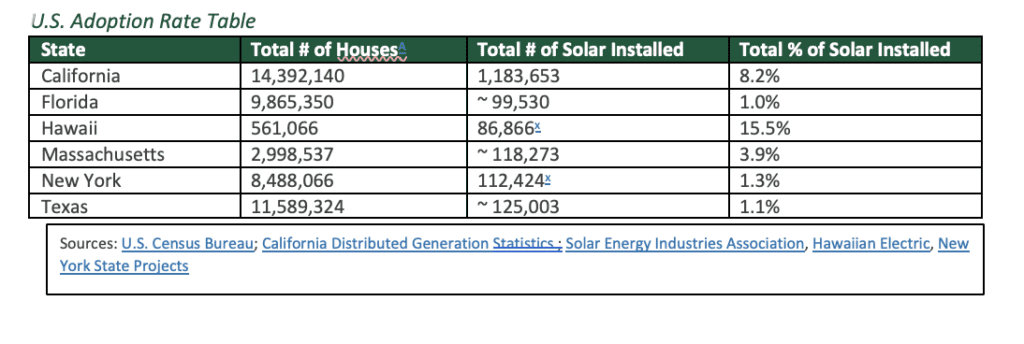A Global Look at Residential Solar Adoption Rates
Credit to Author: JD Dillon| Date: Fri, 29 Jul 2022 16:50:13 +0000

Solar technology is advancing at a rapid rate, making solar easier to adopt. However, there is still a large potential of growth when it comes to the solar market.
Looking at global data, solar photovoltaic (PV) generation has steadily increased for the past several years, and showed the second-largest absolute generation growth of all renewable technologies in 2020, just behind wind and just ahead of hydropower, according to the International Energy Agency (IEA). A recent analysis from the U.S. Energy Information Administration said global rooftop solar PV installations are expected to jump to almost 95 GW by 2025, up from 59 GW last year.
COMMENTARY
It is important to note the various reasons why some countries and states may have low residential adoption rates. In some locations, irradiance, or the amount of sunlight a location gets, may be low, making solar a less viable energy source. In other cases, electricity prices may already be low, reducing the need to have a solar system installed, and a lack of incentives may make going solar more expensive than drawing power from the grid.
Lastly, a country’s residential buildings may be unsuitable for a solar system due to the buildings’ structural integrity or the building type.
The goal of this report is to take a deeper dive into different regions and look at what the residential solar adoption rates look like, as part of an analysis of the potential growth of the industry.
U.S. Leads North America
The U.S. is the leading country in North America (Figure 1) when it comes to installed solar capacity. The cumulative residential solar installation capacity is about 22,151 megawatts (MW), and the total residential solar adoption rate is about 3%, assuming the average residential solar system size is 5 kilowatts (kW). But the U.S. is a large country, so let’s focus on some states to give you a better picture of the adoption rates by region. The table below (Figure 2) shows the percentage of solar homes in eight U.S. states, calculated by using data on the total number of houses from the 2020 U.S. Census and number of solar houses from a variety of sources.

The variation in the residential adoption rate by state is due to multiple factors, including weather, incentives, utility rate plans, incidence of homes, and more. For instance, Hawaii relies heavily on imported energy, which results in high electricity prices. Therefore, Hawaii has turned to solar to produce its own electricity at a much lower cost. On the other hand, one reason why Florida has lower residential adoption rates is due to the low electricity prices, which result in longer payback periods for homeowners. California, on the other hand, has a mix of excellent solar potential, high electricity rates, and incentives, which enable shorter payback periods for residential solar installations.

Canada
Canada has the lowest installed solar capacity in North America. A reason for that is due to weather conditions and the amount of sunlight Canadians see on average every year. The average photovoltaic power output is 3.8 kilowatt-hour per kilowatt peak power (kWh/kWp). But because Canada is so large, every city has varying degrees of sunlight. So similar to some parts of the U.S. with low power prices, installing a residential solar system is not worth it for every household.
Instead, Canada has created utility-scale solar PV farms to generate clean energy to distribute to homes. More than 96% of Canada’s solar capacity is located in Ontario. In total, 0.5% of Canada’s total electricity came from solar, but in 2020 Canada installed 70 MW of solar and plans to continue to increase their solar capacity. Read Canada’s 2050 solar plans here.
Germany
Germany is the leading country when it comes to solar capacity in Europe. Germany has long supported and incentivized solar deployments, and as a result has a relatively high penetration of residential solar installations and solar companies.
There are an estimated 11.7 million one- and two-family houses that are suitable for a solar system in Germany; at the end of 2020, it was estimated more than 1.3 million systems were installed. Therefore, the residential adoption rate is about 11%.
Italy
In Italy, the total number of installed solar PV systems from 2009 to 2020 was about 7 million. From 2016 to 2020, there were roughly 3 million residential solar installations. In total there are about 26 million households in Italy, meaning the solar adoption rate is around 23%.
Netherlands
In the Netherlands, there are roughly 8 million houses, and 1.3 million of these houses have solar installed. Therefore, the residential adoption rate is roughly 16%.
United Kingdom
Although the UK is associated with constant rain or gloomy weather, solar accounts for around 4% of Britain’s total electricity generation, and solar is the third most-generated renewable energy in the UK. In total, the installed solar capacity from 2010 to 2020 was about 86 gigawatts (GW),and there are around 1 million homes with solar panels installed. If we divide that amount to the 25 million homes in the UK, the residential adoption rate is about 4%.
Africa
Africa is the hottest continent on Earth and has the most sunlight compared to any other continent. Therefore, the solar generation potential is very strong. However, since many countries in Africa are developing, adopting solar may not be a financially sound thing to do for many.
South Africa
In South Africa, the current cumulative solar capacity as of December 2021 is 4,172 MW. Large-scale PV represents more than half of the solar capacity; about 20% consists of residential systems. However, the residential adoption rate is quite low due to the affordability of solar.
Many low-income households rely on government electricity subsidies, like receiving 50 kWh of free electricity per month, but about 70% of low-income households rely on other sources of energy (such as wood and paraffin) to satisfy their basic energy needs.
JA Solar, a solar company based in China, is working with a South African construction company to provide suburbs with off-grid PV kits systems to be installed on the roofs of low-cost houses to help satisfy the energy needs of households with free electricity.
Brazil
Similar to many countries in Africa, Brazil is a developing country, but it has taken a bigger leap into the solar industry compared to Africa. In total, there are about 4,000 solar power plants in Brazil, and solar is installed on an estimated 480,000 homes. This estimated amount considers the 2.4 GW of residential capacity that was installed from 2017-2021, according to the IEA. The average residential solar system size in Brazil is 5 kW. In total there are about 72 million houses in Brazil, making the residential adoption rate less than 1%. However, there are estimates that by 2026, 29 million residential units will prepare to have solar panels installed on their roofs, which would increase the residential adoption rate potential to 40%.
China
China is the biggest contributor to the global solar capacity and represents 31% of the global total. However, most of this power is coming from large-scale solar farms. In fact, China has some of the biggest solar farms, behind only India. But when it comes to residential solar installations, it is still a work in progress.
A document released by the National Energy Administration called for a trial program to promote rooftop solar projects, with a goal to have at least 20% of all residential rooftops equipped with solar in 25 provincial-level regions. This program will help increase the availability of rooftop solar in rural areas, and will help China reach a carbon dioxide emissions peak by 2030, and carbon neutrality by 2060.
Japan
When it comes to residential solar, Japan runs into a few challenges. The size of Japan is comparable to California or Sweden, but Japan is three times more populated than California, and 10 times more populated than Sweden. To accommodate the population, Japan has turned to apartment dwellings. In 2018, there were more than 62 million dwellings, and about 44% of occupied dwellings were apartments. So, roughly half of residential buildings are apartments, which makes installing solar more challenging than independent buildings. There is also a need to earthquake-proof buildings, which adds to the challenges.
However, the Ministry of Economy, Trade and Industry released a report with the goal to zero-out carbon emissions by 2050, which may require a solar capacity of 370 GW. To reach this solar capacity, every house or apartment built during or after 2040 will need to have solar panels installed. To read more about Japan’s strategy of reaching carbon neutrality, see this report.
Australia
When it comes to residential adoption rates, Australia leads the pack. In total, there are about 9 million dwellings in Australia, and there are 2.8 million residential solar systems installed. As a result, 31% of homes have adopted solar.
But Australia is not stopping there. By the early 2030s Australia plans to have solar installed on half of all homes to reduce the need for coal-generated power.
Analysis
As mentioned above, many countries are still working toward the goal to have more solar installed on residential homes, and have a working strategy to reach their achievements. Currently, Australia is the ringleader when it comes to the highest residential adoption rates, at 31%.
To see the bigger picture of what it would look like if the countries mentioned previously also had this adoption rate, we’ve done some calculations. We’re looking at more than 91 million homes with solar, and a residential capacity of about 456 GW of power.
If the adoption rate is 100%, we are looking at about 295 million houses and 1,473 GW of power. That’s the equivalent of planting 30 billion trees and taking 1.86 billion cars off the road by absorbing the car’s carbon emissions.
This would be greatly beneficial for the planet while saving homeowners money on their utility bills. These numbers and calculations are only using the countries mentioned above, so the potential is even greater if we add in every country on Earth. If we integrate commercial buildings, the potential increases even more.
Summary
Solar is already the lowest-cost form of energy production in the world and costs continue to decline. As countries implement plans for increased renewable energy in their mix, it’s clear that rooftop solar is going to have a prominent role. Based on this analysis of adoption rates, there is an enormous potential for growth in all the countries reviewed, even the ones like Australia that have relatively high solar penetration. To quote Al Pacino in Scent of a Woman, “[Solar is] just getting’ started!”
—JD Dillon is chief marketing officer for Tigo Energy.
The post A Global Look at Residential Solar Adoption Rates appeared first on POWER Magazine.